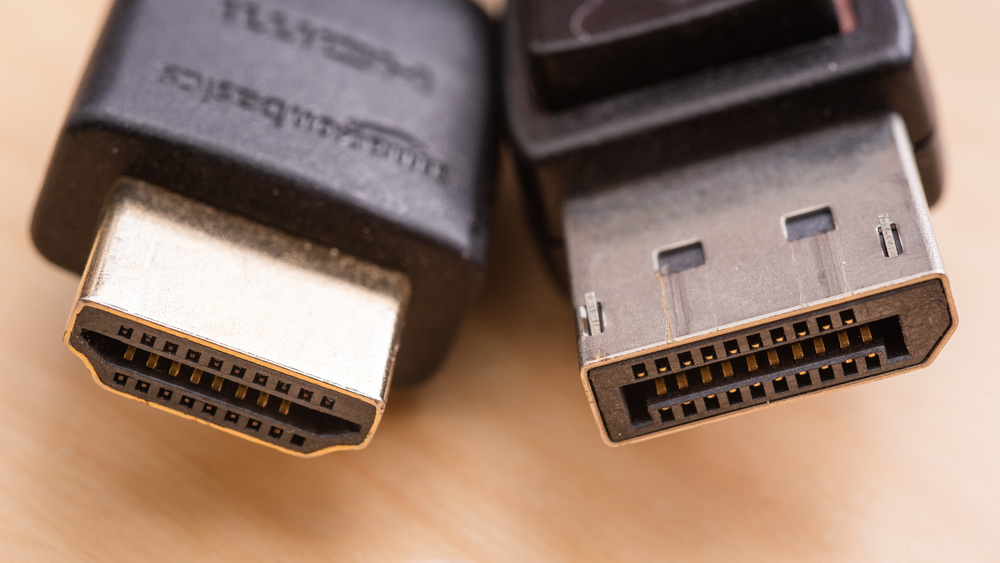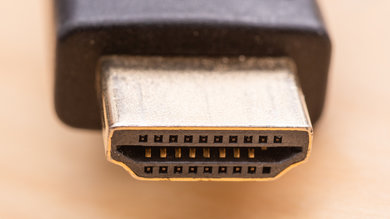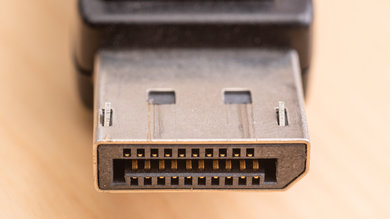
HDMI and DisplayPort are two of the most common media interfaces that you can use to transfer audio and video signals to your display. When comparing HDMI vs DisplayPort, you'll notice that most multimedia devices like TVs and Blu-ray players only have HDMI inputs. Computers and monitors tend to have both inputs, so it begs the question: which one should you use with your monitor? Let's compare DisplayPort vs HDMI to see some of the differences between the two media interfaces to help you make that decision.
Physical Differences
HDMI and DisplayPort connections are physically very similar. HDMI uses a 19-pin cable, while DisplayPort has 20 pins. Most DisplayPort connectors have a physical latch that prevents them from being disconnected accidentally, even if it isn't part of the DisplayPort standard. On the other hand, very few HDMI connectors have latches.
While the most common inputs and cables have the standard HDMI and DisplayPort connector types, Mini HDMI, Micro HDMI, and Mini DisplayPort connectors also exist. They're smaller but still support the same media formats and bandwidth. Only a handful of monitors have these connections, though.
Maximum Cable Length
| HDMI | DisplayPort |
|---|---|
|
|
Although there's no maximum cable length for officially certified HDMI cables, longer cables have a greater chance of introducing issues, like dropped signals. Because of this, for a cable to receive HDMI certification, it needs to properly work at whichever length it's available. Of course, plenty of HDMI cables out there don't have official certification, so it can be easy for manufacturers to make longer cables and claim they work, but buying one of these poses a risk that they won't work.
The same issues occur with long DisplayPort cables. Because of this, DisplayPort has set a recommended maximum length of 10 feet, but most cables are shorter than that, particularly those that support higher bandwidth. Like with HDMI cables, you can easily find longer ones, but they may not work.
Another thing you may want to consider for both HDMI and DisplayPort cables is that there are both passive and active cables available. Passive cables are more common, as they're the cables most of us use with our monitors. They transmit data without any extra power or processing. Active cables contain internal electronics that amplify the power and must be connected in a proper direction from the source to the display. The main advantage of using an active cable is that they support higher bandwidth at longer lengths, even more than 15 m, and some may use different cable technologies, like fiber optic. This is also why there's no real maximum cable length you can use for HDMI or DisplayPort, but you just need to make sure you're buying the proper cable for your setup. However, keep in mind that active cables are more expensive.
Versions and Bandwidth
Both HDMI and DisplayPort have released different versions throughout the years with various bandwidth limitations and supported formats. Both DisplayPort and HDMI have released slight revisions of their initial releases, so sometimes you may see HDMI 2.0 called HDMI 2.0a, for example. Below, you can see some of the features of more recent HDMI and DisplayPort versions. There are older versions, like HDMI 1.0 through 1.4 and DisplayPort 1.0/1.1, but these aren't common on monitors anymore.
However, not all monitors allow the maximum bandwidth of the version they support. For example, there are HDMI 2.1 monitors with 24Gbps bandwidth and DisplayPort 2.1 monitors that support UHBR10 with 40Gbps bandwidth. Technically, these are still HDMI and DisplayPort 2.1 monitors, but just not at the full bandwidth the version supports.
HDMI announced version 2.2 at CES 2025. It offers double the bandwidth as HDMI 2.1, but it will likely take some time before monitors are equipped with it.
| Type | HDMI | DisplayPort | ||||
|---|---|---|---|---|---|---|
| Version (Alternative Names) |
2.0 (2.0a, 2.0b) |
2.1 (2.1 a, 2.1 b) |
2.2 | DP 1.2 (1.2a) |
DP 1.4 (1.4a) |
DP 2.1 (2.0, 2.1a) |
| Release Year | 2013 | 2017 | 2025 | 2010 | 2016 | 2019 |
| Max Bandwidth | 18Gbps | 48Gbps | 96Gbps | 21.6Gbps | 32.4Gbps | 80Gbps |
| Compression | No | Yes | Yes | No | Yes | Yes |
| HDR | Yes | Yes | Yes | Yes | Yes | Yes |
Supported Signals
The maximum resolution and refresh rate you can get depend on the specific versions of both your monitor and your source, as it's limited to the lowest common denominator. This means you can have an HDMI 2.1 monitor, but if your graphics card only supports HDMI 2.0 bandwidth, your signal is limited to HDMI 2.0 bandwidth. Conversely, if you're using an HDMI 2.0 monitor with an HDMI 2.1 source, the bandwidth is still limited to HDMI 2.0 bandwidth. Essentially, the max resolution and refresh rate depend on the lowest bandwidth available from both your source and monitor.
Below, you can see the max refresh rate with common resolutions using uncompressed 8-bit and 10-bit signals with chroma 4:4:4. You can use Display Stream Compression (DSC) to reach higher refresh rates as long as your graphics card supports it, which most do. Although DSC is advertised as visually lossless, it can still create some artifacts or prevent certain features from working, like DSR/DLDSR.
Keep in mind that the refresh rates below are theoretical maximums, and the maximum refresh rate that you can get with your monitor is often below that. Most of the time, a monitor uses DSC to reach higher refresh rates, and its max refresh rate is a common refresh rate, like 144Hz, 240Hz, 360Hz, etc., and you'd need to create a custom resolution to get a different refresh rate. Also, keep in mind that, ultimately, the max refresh rate also depends on the monitor's max bandwidth. As mentioned, there are monitors that support lower bandwidth than the maximum their version supports, in which case, you'll get a lower max refresh rate.
| Resolution | Color Depth | HDMI 2.0 | HDMI 2.1 | HDMI 2.2 | DP 1.2 | DP 1.4 | DP 2.1 |
|---|---|---|---|---|---|---|---|
| 1920x1080 | 8-bit | 246Hz | 589Hz | 1178Hz | 289Hz | 406Hz | 885Hz |
| 10-bit | 202Hz | 499Hz | 998Hz | 238Hz | 338Hz | 771Hz | |
| 2560x1440 | 8-bit | 147Hz | 379Hz | 758Hz | 174Hz | 251Hz | 610Hz |
| 10-bit | 119Hz | 314Hz | 628Hz | 142Hz | 206Hz | 517Hz | |
| 3440x1440 | 8-bit | 112Hz | 297Hz | 594Hz | 133Hz | 194Hz | 492Hz |
| 10-bit | 91Hz | 245Hz | 490Hz | 108Hz | 158Hz | 412Hz | |
| 3840x2160 | 8-bit | 69Hz | 188Hz | 376Hz | 82Hz | 120Hz | 324Hz |
| 10-bit | 55Hz | 153Hz | 306Hz | 66Hz | 97Hz | 267Hz |
We also test for the max refresh rate on every monitor we review, including without DSC if it has an option to turn it off, so it's best to check our reviews if you want to know its max refresh rate.
Key Features and Differences
Each interface supports a few features, so choosing to use one over the other can also depend on which features you want to use. Below are some examples.
Multi-Stream Transport (MST)
First introduced with DisplayPort 1.2, Multi-Stream Transport (MST) allows you to connect multiple displays to each other in a chain from a single DisplayPort connection on your computer. This is also called daisy chaining, and it can be used with a compatible monitor that has a DisplayPort output or an external hub. Although the total bandwidth can't exceed the maximum bandwidth of the port you're using, in theory, this technology allows you to run up to 63 separate displays on a single port.
HDMI doesn't natively support MST, but it's possible to achieve similar results using DisplayPort to HDMI hubs. This still requires a DisplayPort connection on the source device.
Variable Refresh Rate (VRR)
Most modern monitors and graphics cards support Variable Refresh Rate (VRR) to reduce screen tearing, which works over HDMI and DisplayPort. The main difference between these two connections is that NVIDIA's G-SYNC technology doesn't work over HDMI with all monitors. Monitors that support G-SYNC over HDMI either support HDMI Forum VRR, which is a feature of HDMI 2.1, or are a native G-SYNC monitor with NVIDIA's chip built in.
If you have an NVIDIA graphics card and want to use VRR, it's best to use a DisplayPort connection unless you know your monitor supports it over HDMI.
USB-C DisplayPort Alt Mode
HDMI and DisplayPort aren't the only way to get video and audio signals from your computer. The most common alternative is using DisplayPort Alt Mode over USB-C. As the name suggests, DisplayPort Alt Mode is a type of DisplayPort media interface, so it supports many of the same features and bandwidth. Devices with USB-C ports, like laptops (including MacBooks and Chromebooks), phones, and even the Nintendo Switch, support DisplayPort Alt Mode, so they can send a video signal over USB-C to a monitor that supports it, too.
There are a few advantages to using DisplayPort Alt Mode over USB-C. Many monitors provide power over USB-C, so you can charge your laptop while using it with one cable. The USB-C port also serves as a USB upstream port, so you can connect your devices directly to other USB ports on the monitor and use them with your computer.
eARC/ARC
One of the most popular features that HDMI has, which DisplayPort doesn't, is eARC/ARC support. This allows you to connect a compatible soundbar over HDMI and passthrough common audio formats from an external source to the soundbar. For example, you can connect your Blu-ray to the display and have a soundbar play high-quality audio signals, like Dolby Atmos or DTS:X. However, this feature is uncommon on monitors and is more common on TVs, so if you have a monitor, it's best to connect your soundbar directly to your multimedia device.
Auto Low Latency Mode (ALLM)
Another feature that HDMI has, and DisplayPort doesn't, is Auto Low Latency Mode (ALLM). This is something mostly TVs support, and it's mainly used with gaming consoles, as powering them on automatically switches the TV's picture mode to Game mode for the lowest latency. However, monitors don't need this feature, as they tend to have low latency in any mode.
Graphics Cards
As mentioned earlier, your device and monitor need to support the same max bandwidth to take full advantage of each other. Many modern graphics cards support at least HDMI 2.1 bandwidth, which NVIDIA GeForce RTX 30 Series, AMD Radeon RX 6000 Series, and newer graphics cards support. There are graphics cards available with DisplayPort 2.1 as well, like Radeon RX 7000 Series and GeForce 50 Series cards.
Compatibility
Lastly, HDMI has an advantage over DisplayPort when it comes to compatibility and availability with devices. Most common devices, from Blu-ray players to soundbars, have HDMI ports, while DisplayPort is mainly available with computers and monitors. While this doesn't make a difference if you have a computer and want to connect your monitor, it's something to consider if you want to connect other devices, like gaming consoles. That said, most monitors have HDMI ports as well.
| HDMI | DisplayPort | |
|---|---|---|
| TVs | Yes | No |
| Projectors | Yes | No |
| Monitors | Yes | Yes |
| Computers | Yes | Yes |
| PS5 & Xbox Series X|S | Yes | No |
| Blu-ray Players | Yes | No |
| Soundbars and Receivers | Yes | No |
| Streaming Devices | Yes | No |
| Cable Boxes | Yes | No |
Performance
Besides the different max refresh rates and resolutions each connection type supports, there really isn't much difference between HDMI vs DP. The picture quality is the same, and more importantly, the response time and input lag for any given monitor are the same, no matter which connection you use. This means that if both connections result in the same max refresh rate, there's no difference in choosing one over the other.
Conclusion
When comparing HDMI vs DisplayPort, you'll see they deliver very similar performance, but they each have advantages and disadvantages. HDMI is supported on more devices, but DisplayPort, which was designed for computers, has a few technical advantages. Overall, if you're looking to connect your computer to a new monitor, choosing which connection type to use depends on your device, as you'll want something that takes full advantage of your computer and monitor's capabilities. With everything being equal in terms of resolution and refresh rate, there aren't any differences in performance between the connection types, so use the connection that can make full use of your setup.

